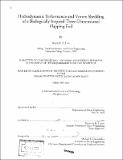Hydrodynamic performance and vortex shedding of a biologically inspired three-dimensional flapping foil
Author(s)
Lim, Keith, K. L
DownloadFull printable version (18.87Mb)
Other Contributors
Massachusetts Institute of Technology. Dept. of Ocean Engineering.
Advisor
Alexandra H. Techet.
Terms of use
Metadata
Show full item recordAbstract
The dynamics of flapping remains a subject a great theoretical and practical interest. Propulsion and maneuvering by flapping, optimized through years of evolution, is ubiquitous in nature, yet marine pulsars inspired by examples of highly maneuverable marine life or aquatic birds remain unheard of. The motivation of this research stems from the notion that better propulsive strategies could be obtained from flapping foils; presenting superior alternatives to the conventional propeller for waterborne propulsion. The propulsive properties of a Nasa 0012 linearly tapered rigid foil, with a .5.5 cm average chord and 24.6 cm span performing a combined roll and pitch motion are investigated. The mean planform area thrust coefficient and efficiency are recorded over a paramtetric space that included three roll amplitudes, with induced heave (at 0.7 span) to chord ratio, ḣ₀.₇ / c = 1.0, 1.5 and 2.0; Strouhal numbers ranging from 0.2 to 0.6 and maximum angle of attack varying from 15 to 45 degrees. Results show that a maximum planform area thrust coefficient of 2.09 is achieved at h₀.₇ / c = 1.5, St = 0.6 and ,[alpha][max] = 30⁰. The thrust and efficiency data also reveal a useful performance trend where at low [alpha][max], high thrust and efficiency can be gained at sufficiently high Strouhal numbers. (cont.) DPIV is next used to study the vortical signature created by the flapping foil. Two planes of view, at mid- and 0.8 span were recorded over regimes of low and high thrust. Results show that the vortex patterns are heavily influenced by the foil geometry and kinematics. Three distinct patterns were observed. In particular, the interaction from the shedding of a mixed vortex pair in the wake unveils evidence of strong thrust production. Vorticity control through the replication of this wake vortex pattern can potentially offer optimal solutions for flapping foil propulsion.
Description
Thesis (S.M.)--Massachusetts Institute of Technology, Dept. of Ocean Engineering, 2005. Includes bibliographical references (p. 129-131).
Date issued
2005Department
Massachusetts Institute of Technology. Department of Ocean EngineeringPublisher
Massachusetts Institute of Technology
Keywords
Ocean Engineering.